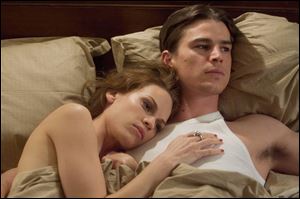
Movie review: The Black Dahlia **
9/15/2006
Hilary Swank and Josh Hartnett in The Black Dahlia.
Brian De Palma's The Black Dahlia tells the seediest, most cynical, and dream-crushing of true-life Hollywood legends. Or rather, the nastiest one from the 1940s. (OK, the late '40s.)
Though the film is fictional - actually, a ludicrous pile of too many fictions, after an eye-popping good start - the murder case on which it's based is ingrained in Los Angeles lore. I remember attending a Halloween party there years ago and a couple arrived dressed as the Black Dahlia.
He was the lower half.
She was the upper half.
Thing is, "Black Dahlia" was the nickname newspapers gave to 22-year-old would-be actress Elizabeth Short. In the film we see her (played by Mia Kirshner) in two ways, both ghostlike: in black-and-white stag films and audition reels, and dead in an abandoned lot, her face cut ear to ear into a grotesque Joker grin, and her body severed in two and drained of blood.
The real Dahlia was so named because Short wandered Sunset Boulevard dressed in black and resembled Veronica Lake in The Blue Dahlia. In life, Short never became a star. She was found murdered in 1947. The case remains the most notorious unsolved murder in Hollywood history.
The movie, however, has a villain, an actual person who did it - just as the novel it's adapted from did, a typically two-fisted James Ellroy panorama of paranoia and pervasive threat. The surprising thing is how De Palma lets it get so literal and out of hand, so unnecessarily cluttered with plot.
This is a man who operates best with blunt extremes and here he's juggling gray areas. Once upon a time, the virtuosic director who gave a sleazy brilliance to Dressed to Kill would have seemed a natural match with the linguistic fireworks of Ellroy, whose books have the repetitive, machine-gun patter of a David Mamet play, juiced to the 10th power.
He's still a dazzling filmmaker. The result here, though, is overripe and way too much of everything, and a familiar everything at that: an old-fashioned crime story and a romance and a mystery and a long peer into Hol-lywood morality. There's even a boxing picture thrown in. But it works better scene to scene, when De Palma is arranging his characteristic Hitchcock-like thrill pieces rather than trying to keep a coherent, absorbing detective story under control.
Which, in a sense, is the story of De Palma's career: quality filmmaking, spotty control, lots to argue about. The picture was shot by the great cinematographer Vilmos Zsigmond, and it's gorgeous. I doubt there's an image in it that doesn't recall an exquisitely composed sun-splashed David Hockney painting or old film noir. (You haven't seen a movie with this much smoking in years, I promise.) And notice the way faces in the background and foreground both stay in focus, and notice the way that '40s crime-movie trick lends confidence.
At times, wisely, Ellroy's pungent dialogue is lifted wholesale into the picture; as it settles into those rat-a-tat beats, the film charms. Josh Hartnett and Aaron Eckhart play L.A. homicide detectives obsessed with the case, and they play every moment jacked to the hilt: Eckhart is a sweaty symbol of police corruption, Hartnett is a scratchy-voiced man full of bitter lessons - a prototypical Bogart, only weightless.
They have a platonic friendship with a voluptuous blonde played by Scarlett Johansson - her steady gaze and ample curves are so suited to vintage Hollywood re-creations, her appearance tends to underline what's contemporary about co-stars like Hartnett. There's also a lipstick lesbian (Hilary Swank) with a wacky Beverly Hills family. Watch for the dinner scene with them that's perfectly nuts. Indeed, their story is a better (and partly true) story in itself, about the way some Southern California fortunes were made reselling old studio sets to the poor as livable homes that eventually became fire traps.
How did we get from the mutilated body of an unknown actress to real estate? That's the uncharted terrain of Los Angeles, and in this respect The Black Dahlia knows exactly what it's doing: As with last week's Hollywoodland, the true villain isn't a person but the town itself and its toxic blend of hypocrisy and class warfare and the promise of fame. That's a hallmark of pulp fiction. As are the flesh-faced cops, the art deco clubs, the veiled faces. But also like Hollywoodland, The Black Dahlia feels so beholden to history, both movie history and the real thing, it fatally overreaches - lured, like so many would-be starlets, by the siren song of ambition.
Contact Christopher Borrelli at: cborrelli@theblade.com
or 419-724-6117.